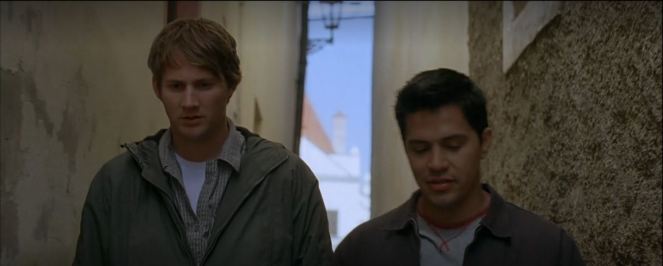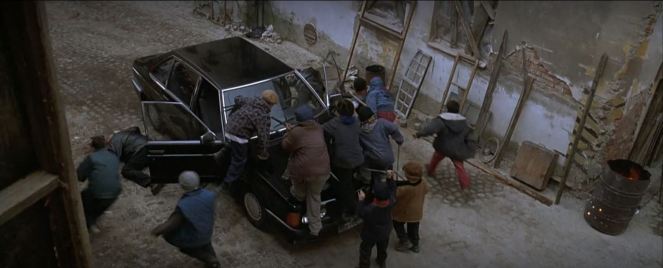
The attraction of horror, to me, lies in its aesthetics. Every audience member pays extra attention to what’s seen and not seen. The killer is hiding. The only thing we see is darkness. Something is obscured. Something is hidden. Body parts. Weapons. The urban decay in a foreign land. Blood. The cool tones in the image. Hostel makes interesting choices in cinematography and editing, and creates memorable sequences, subvert expectations, and above all else, put fear in the audience.
Now, Hostel is different from many horror films as part of the torture porn subgenre. It grosses people out, sickens them even. Released in the mediocre mid-2000s horror period, it pushes people to the limit. The torture porn subgenre isn’t for everyone, but I want to highlight the inner workings of Hostel in regard to its narrative structure and aesthetics. Basically, the film doesn’t use characters as a means to get the kills and the thrills. The expectations that the audience have are known, and the film works against them.
I won’t heavily delve into the psychology and politics of torture porn right now, because it’s a complex subject. There are essays that discursively analyze the socioeconomic politics and narrative of Hostel in depth, drawing comparisons to torture by soldiers in the Bush era and how Hostel evokes fears from 9/11. I find the connections to be persuasive, but instead of offering my own take, I’d rather review Eli Roth’s filmmaking decisions, how he presents his world and builds suspense.
Hostel has a very basic reversal structure, and it took me by surprise. The words people use in reference to Hostel are “disgusting,” “without purpose,” and “shock value” but there’s a breakdown of the spectator’s expectations in the film. For one, the opening has an unseen whistling person cleaning up a murder. From this point on forward, I expected the villain to only be a single person. As it turns out, the villain is an organization that fuels people’s sadistic desires.

The film centers around three main characters: Josh (Derek Richardson), a white American, Paxton (Jay Hernandez), a Latino American, and Oli (Eythor Gudjonsson), a white Icelander. The white American male, due to our experience with the Hollywood film, feels like the main character that will survive throughout the film. But, it is Paxton, who uses “gay” as an insult, misbehaves toward women, and acts as the typical annoying American, that becomes the survivor. This is one of the major reversals in the movie few people would expect.
In the beginning, the three friends are on a road trip through Europe, fulfilling their roles as sex tourists. The first major section of the film has the three sex tourists go to a brothel, which sets up a commentary on human trafficking and the human killing underworld. The inciting incident would be learning about the “easy sex” at the eponymous hostel in Slovakia, and the sex tourists travelling to live out their promised libertine fantasies. The third major section, past the midpoint, is where the film delivers its horror; Paxton uncovers the underworld in Slovakia and escapes it. The resolution has Paxton enacting revenge as a survivor.
As I said, the brothel mirrors the underworld section, which isn’t a reversal of expectations but still sets up a parallel structure that the film is built around. In the brothel, the camera moves down the long neon lit hallway focusing on each room, sexual acts heard in each one. In the torture sequence, Paxton is dragged down a hallway, glimpsing terrifying acts in every torture room, hearing the final screams of victims. The two sequences are remarkably similar in introducing two worlds, one sexual and one violent, thereby connecting the two concepts in a complex relationship. At one point in the brothel, Josh thinks someone is hurt, and barges in. In this mini reversal of expectations, Josh learns that the subject wanted to be hurt by the prostitute. The pain is real, but the man’s life is not in danger; at the same time, he’s in control and the dominatrix is in control. The dominatrix then says that Josh has to pay to watch, but he leaves, while Oli and Paxton enter to spectate the spectacle of a bodily exchange between a john and a prostitute. In the horror section, Paxton goes in the room where he knows the american client (Rick Hoffman) is torturing Kana, an Asian tourist. The man says get out, and Paxton shoots the man to save Kana. The power and pain structure between the two scenes may not be perfectly inverted, but the comparison of buying a human for services is clear based on these interactions. Human trafficking, the slavery of the modern age, exists in tandem with legal prostitution, and importantly, Americans aren’t exempt from it, especially when they’re on a sex tourism romp. The sex tourists, having used women for their bodies, find themselves in a foreign land used only for their bodies, although for lethal and malevolent reasons.

The most interesting part of the movie to me, that few people mention in their reviews, is the role of the kids. The Slovakian children epitomize the normalization of violence, since they act as a gang taking what they want from whoever. Josh’s killer, the unnamed Dutch businessman (Jan Vlasak), says they attack anyone and commit the most crime. This proves useful later, when Paxton gives them candy to kill the men following him. The act of exchanging candy for murder is the third type of buying bodies, and all the more strange that it happens with kids. The deaths by the children are fully shown, with them bashing the two men in the head with rocks. The scene isn’t a usual horror sequence, but it’s part of what makes the film disgusting, in its own way.
More than most films, Hostel is particular about what violence it does show, because it actually shows less than what audience members probably remember, judging by their comments. The famous example is in Josh’s death scene, where we don’t see what the Dutch businessman is doing to him, and we have to imagine him slicing Josh’s Achilles heels and his throat. In another quick scene, a woman is screaming as her killer walks toward her. In an extreme close up, the killer is about to remove the woman’s toes with a pair of cutters, but the film transitions to the victim’s friend cutting her toenails. The violence is not shown at all, even more, the transition is almost comical.
Furthermore, Paxton’s torture sequence lacks a lot of physical torture, opting to go with mental anguish instead. The film teases us with what his German torturer will do to him. After holding a gun up to his head, the German looks offscreen and the next shot is a close up of Paxton’s legs behind his chair, near the ground. Paxton is frantically moving around, trying to get out of his shackles—until he hears the hum of a chainsaw. His body goes still. The camera rises to his hands gripping the back the chair and continues to a close up behind Paxton’s head. The music starts up again revving the audience in anticipation. Eli Roth favors a strategic, implied type of filmmaking to merely torturing his characters as much as possible, something that many reviewers don’t see.
The gross factor in Paxton’s torture scene doesn’t only occur when he gets his fingers sawed off; that type of violence is mild compared to horror movies that aren’t “torture porn.” What I suspect grosses audiences out, besides the unsanitary torture chamber, is Paxton vomiting with a ball gag in his mouth. Human bodily fluids that aren’t blood are almost rare in horror films. When it isn’t blood, it’s usually vomit. The most disgusting torture is done to the Asian woman, Kana, that involves a face on the receiving end of a blowtorch and an eye drooping off her face before it’s cut off. Make no mistake. It is disgusting to watch, but the film isn’t laden with images like these, though it’s likely what people have in mind when they remember the film, because it is shocking.
There are many more interesting details in the film that go beyond the scope of this reappraisal, but I chose to focus on the narrative and visual choices made in the film. Hostel is one of the definitive films of its era, and it’s still effective today, going by my recent viewing. As far as the torture porn genre goes, Hostel cuts away more than it cuts into its characters.



